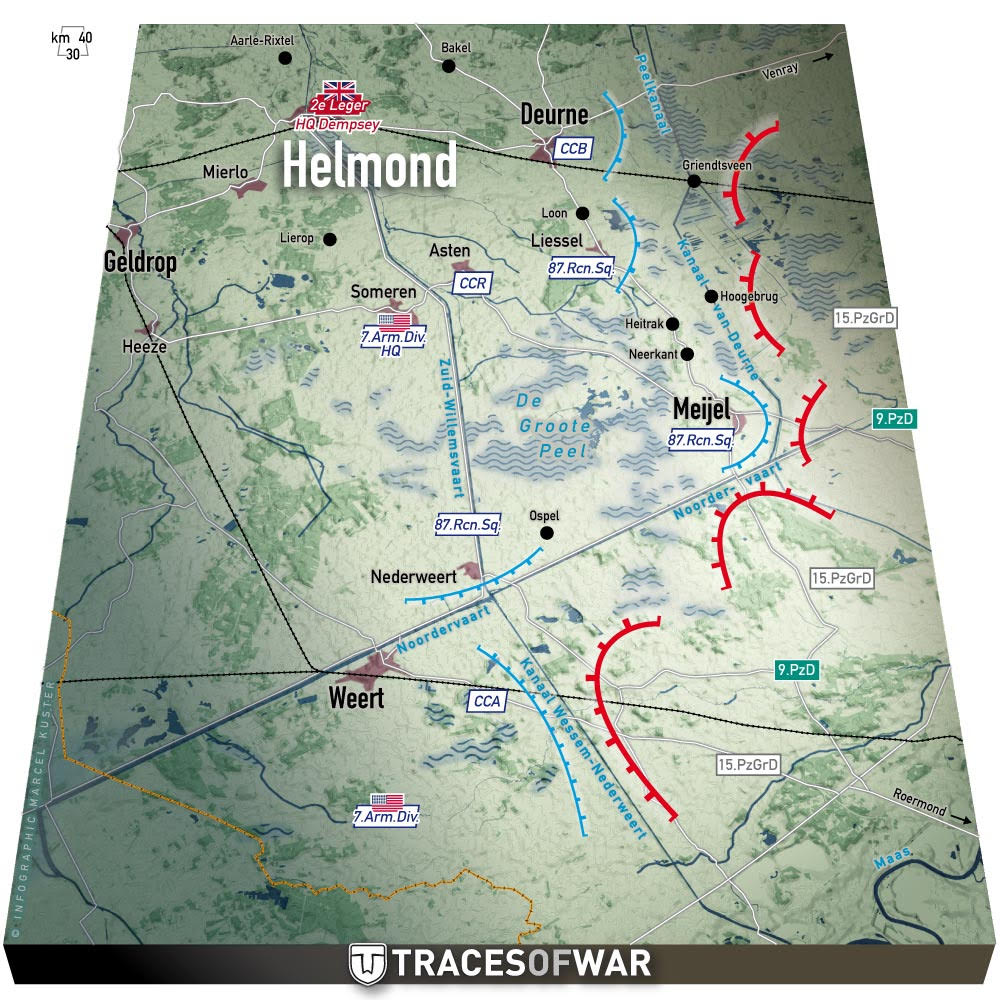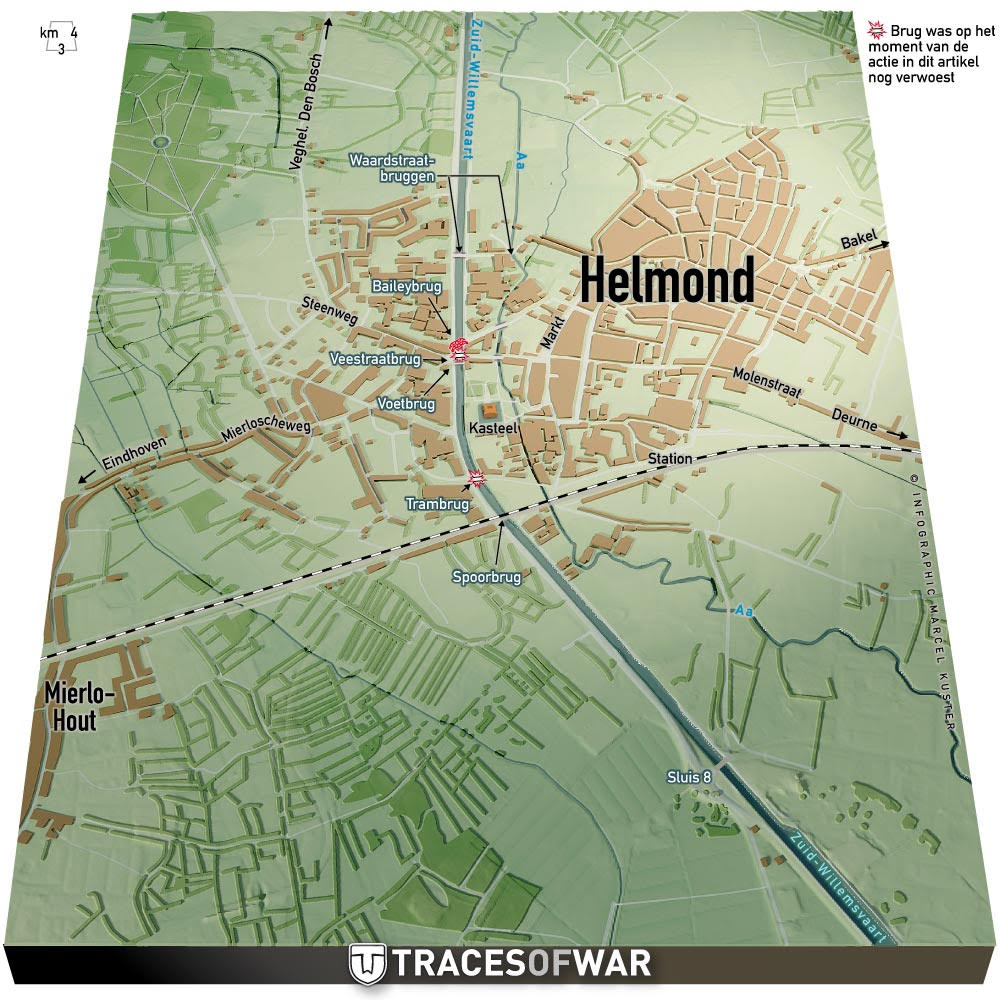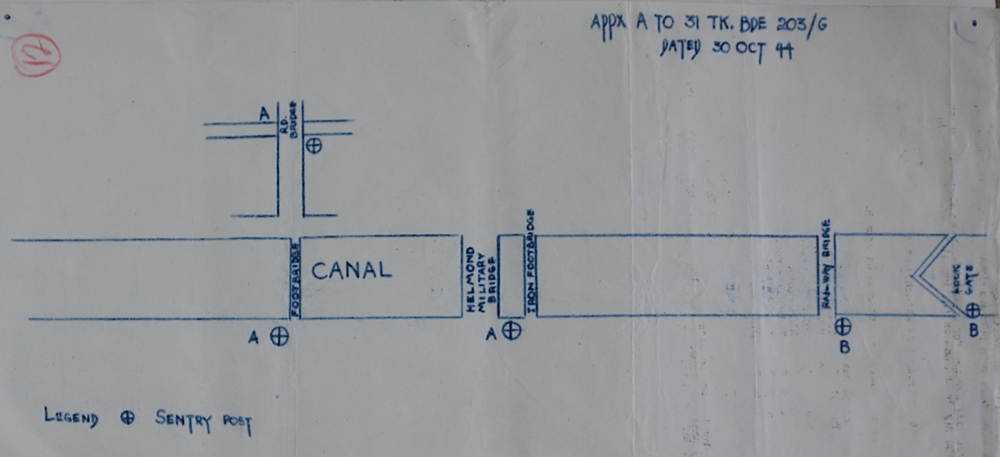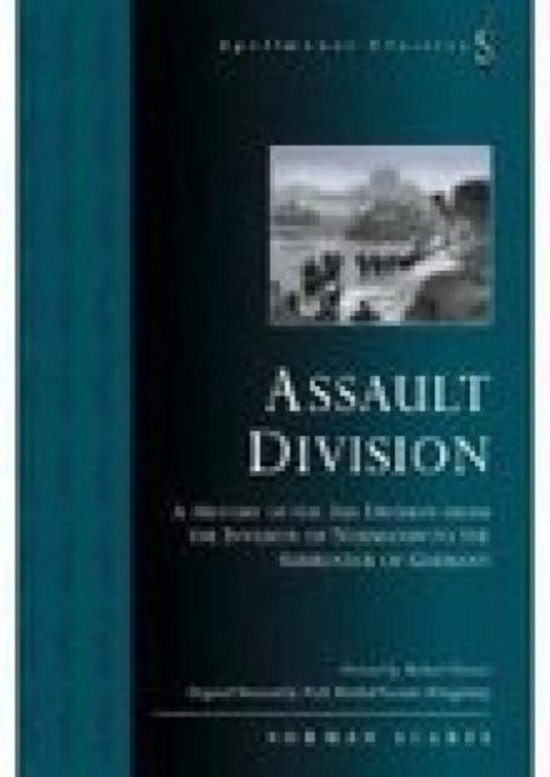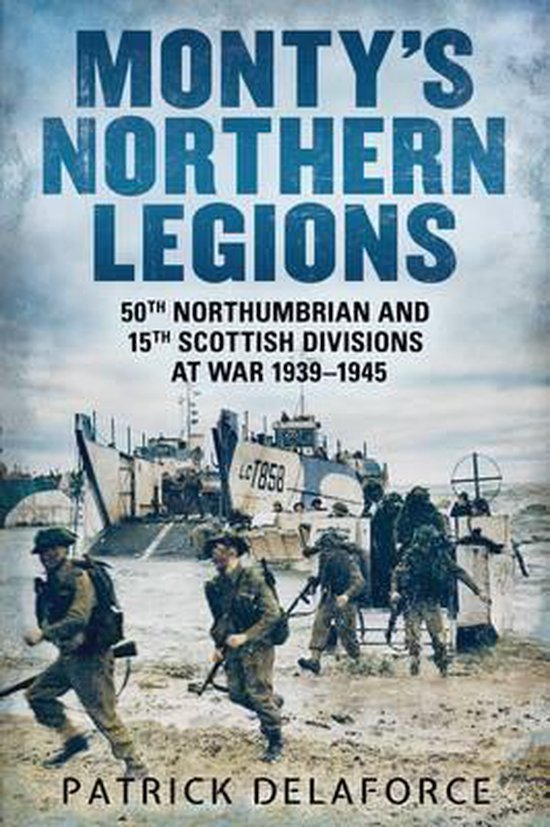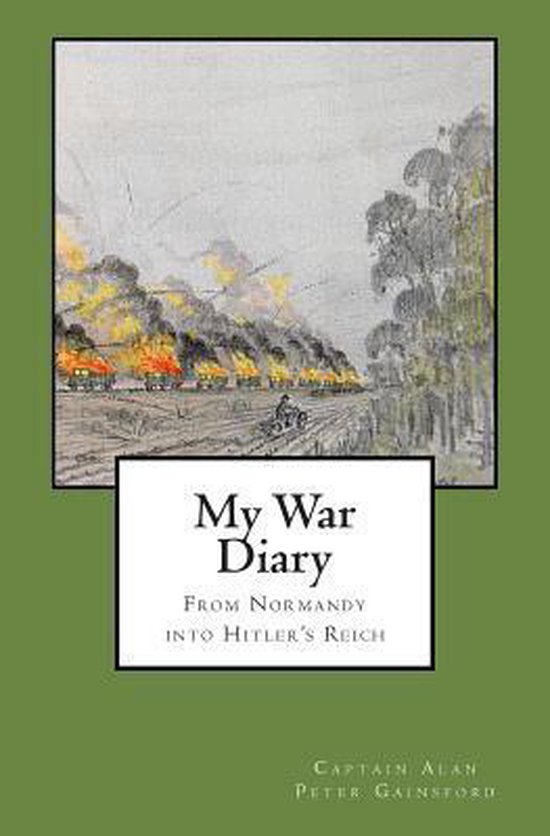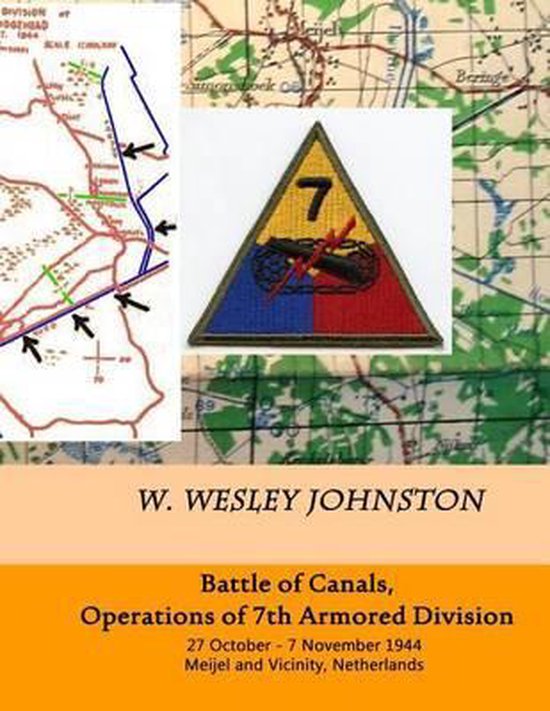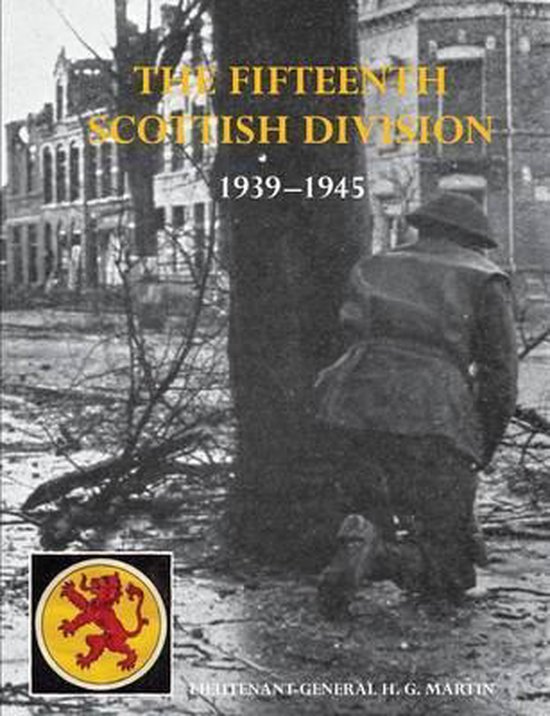Introduction
In mid-October 1944, Helmond was transformed from occupied territory to a rest and recuperation area for allied troops. Allied headquarters were established in extravagant mansions on the west bank of the canal, and in other places, such as in the mission Christus Koning in the Brouwhuis district. An atmosphere of calm reigned. At the same time, peace was being celebrated and the whole town buzzed with parties, although some were only open to the local ladies. The allied soldiers did not tolerate competition from Helmond men.[1]
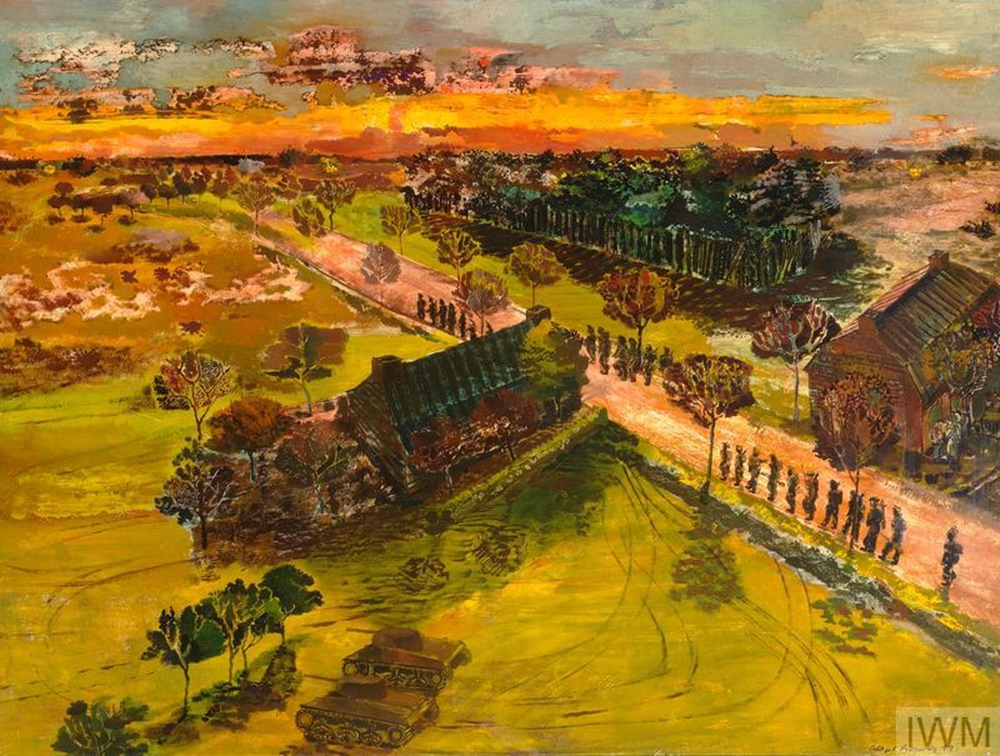
Albert Richards was a British painter serving in the British army. He captured several battlefields on canvas before his death from a landmine on March 5, 1945. Infantry from the 15th (Scottish) Division taking over the frontline from American forces during the German counterattack near Meijel Source: IWM ART LD 4829.
Appearances can be deceptive ….
In October 1944 the Battle of the Scheldt was raging in Zeeland. The battle required a large amount of allied units, meaning that other parts of the front line could not be defended as well as before. Helmond had been liberated on September 25 and the front line now ran through De Peel. This are was defended by the American 7th Armored Division defending a front of some 25 miles.[2] From north to south, Combat Command B (CCB) defended the area around Griendtsveen. The 87th Reconnaissance Squadron patrolled the area south of Griendtsveen and east of Liessel, along the Deurne canal and the Noordervaart to the town of Nederweert. Combat Command A (CCA), together with the Belgian Brigade Piron defended the area to the south, along the Wessem-Nederweert canal to the river Maas at Ophoven. Combat Command R (CCR) was held in reserve near Asten.[3].
The Nederweert-Meijel-Grientsveen triangle was of especial interest for Helmond. As mentioned above, this area was primarily patrolled by the 87th Reconnaissance Squadron. In the beginning of October, the area was still quiet, but towards the end of the month more and more German patrols crossed the canal.[4].
On 27 October at 07:18 a.m., German troops crossed the Deurne canal and the Noordervaart. Attacks were reported against Heitrak, Neerkant, Meijel and Ospel. Meijel was quickly occupied by the Germans[5], specifically 9. Panzer-Division and 15. Panzergrenadier-Division[6]. Early messages mentioned attacks of platoon and company strength. The full divisions were not immediately deployed[7]. At approximately 11:00, the first German tanks were observed on the western side of the canal. They crossed the Deurne canal near Hogebrug, to the east of Liessel[8]. Reports indicated that Tiger tanks were in use.[9].
Van de Werff was living in Helmond and wrote in his diary: 'On the 27th [October] there was a Kraut attack, Meijel is once again occupied territory. It’s still very close, and maybe I shut the cellar too early after all.'[10]. That evening, the Germans on the western flank slowly advanced towards Nederweert, however on the eastern flank they had passed Heitrak. The Americans had meanwhile thrown CCR into battle and the CCB stationed at Grientsveen was freed up to move to the south.[11].
On October 28 at around noon it was decided to send the 15th (Scottish) Infantry Division to the area. They had just liberated Tilburg and had sent the first units in the direction of De Peel, where they arrived the next morning[12]. The Scotsmen were not 'overly enthusiastic' to leave the celebrations in Tilburg[13]. One of the Scotsmen was G. Wilson: 'I remember when we left Tilburg we drove past a monastery where beer was made. The road is dead straight there, and you think that you are just about to drive through the gate, but you take a left turn just before it.'[14] The monastery referred to is the abbey Onze Lieve Vrouw van Koningshoeven in Berkel-Enschot, on the old Tilburg-Eindhoven road.
All of this didn't pass unnoticed in Helmond as the German attack was directed towards Helmond. The various headquarters were beginning to get worried. The British Second Army, headquarters of General Dempsey.[15] left fot Geldrop quickly.[16] The mayor also prepared to leave. His driver, Jac Ottenheijm, recounted: 'At that time we had to make sure that the mayor’s things were all packed. And the secret service’s maps and documents had to be all packed up again and ready to leave, go!' In the end, the mayor remained in Helmond[17].
At 19:15 on the October 28, a number of bomb impacts were reported close to the Steenweg and Mauritslaan in Helmond. Next to the Steenweg, a bomb fell causing a number of wounded. The situation on the Mauritslaan was recorded by a Mr Niessen from Helmond who wrote in his diary: 'An English motorcyclist lay on the road mortally injured and died shortly afterwards. In a tent there was one dead and a dozen wounded, in another tent we found another dead. [...] A bomb also exploded behind the house of Baron van Hardenbroek van de Kleine Lindt, killing the two boys and seriously injuring the lady.' Bertram Hoogenboom was also wounded and would later die from his injuries.[18].. Twenty-two bomb craters were counted and eight duds were found. The bombs were of approximately eight pounds. The duds were defused on October 30 by the British army[19].
The British 3rd Infantry Division was also stationed in and around Helmond, and its divisional club was based in town. 'here was a jolly and homely atmosphere, and the men spent their 24 hours leave there. [...] The permanent residents of the Club found the news especially alarming, although the whole division was on alert, even more so than before.'[20].
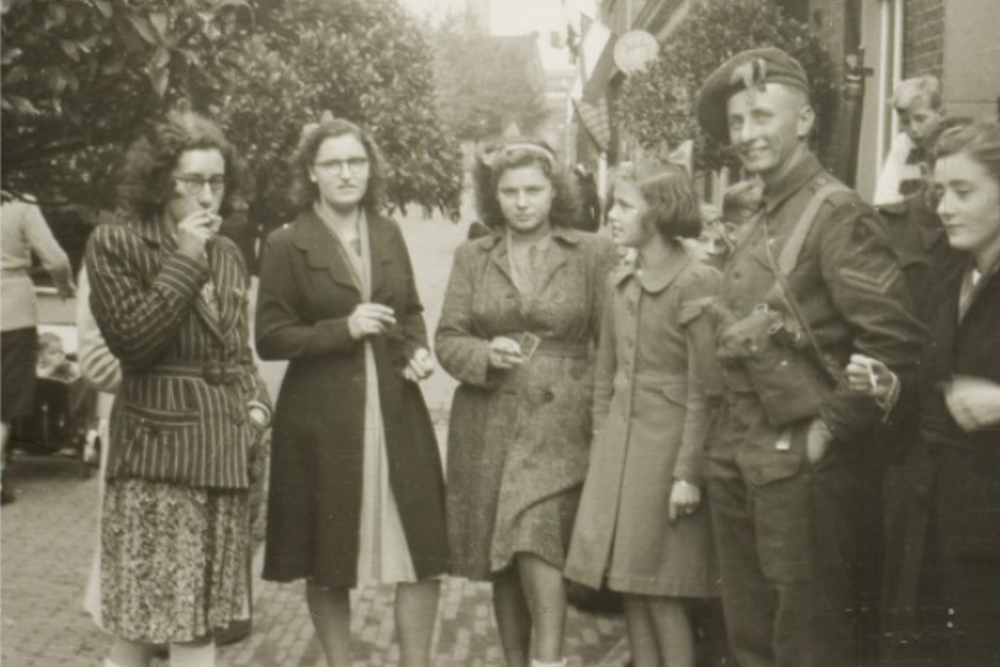
Helmond women with a British soldier during the liberation of Helmond Source: Photo archive Jeroen Koppes.
Helmond had to be defended. At that time, there were an especially large number of repair shops and engineers in the city. The headquarters of the 31st Tank Brigade was also located there[21]. They were part of the 79th Armoured Division, the famous Hobart’s Funnies. This was a specialised division that had a lot of many different types of tanks at its disposal, not only flame-throwing Crocodile Churchill tanks, but also flail tanks for clearing minefields. At that time, the brigade only had the 141st Regiment Royal Armoured Corps under its command, but that was split up and deployed elsewhere. Only the brigade headquarters remained in Helmond[22].
Definitielijst
- Brigade
- Consisted mostly of two or more regiments. Could operate independently or as part of a division. Sometimes they were part of a corps instead of a division. In theory a brigade consisted of 5,000 to 7,000 men.
- mid
- Military intelligence service.
- Regiment
- Part of a division. A division divided into a number of regiments. In the army traditionally the name of the major organised unit of one type of weapon.
October 29
On 29 October, Liessel was captured by the Germans.[23]. The same day, the 31st Tank Brigade carried out instruction no. 16 organizing the defence of Helmond. According to this document, German tanks (including Tigers) had broken through the American positions and had crossed the Deurnese canal near Meijel.[24].
The brigade was commanded by Brigadier G.S. Knight, who was entrusted with the ad hoc defence of Helmond. The taskforce that was established for this purpose was given the fitting name ‘Knightsforce’. Knight wouldn't be present all the tine, having taken special leave on October 26. Lieutenant-colonel Oliphant[25] took over command from this point on.[26]. He was in command of a variety of troops, divided into four forces:
- Triangle Force, named after the emblem of the 3rd Infantry Division,
- Lion Force, named after the emblem of the 15th (Scottish) Infantry Division,
- Mercury Force, likely named after the mercury in the radio valves that belonged to the liaison units,
- Dynamite Force, responsible for explosives.
All troops taking part in the defence were subordinate to Knightsforce.[27]. They were given a clear order: 'Knightsforce will defend Helmond'.[28]. The whole operation was given the codename ‘Kent’.[29].
A random array of units was involved. There were repair shops and so-called battle schools: training units belonging to larger formations like divisions and brigades, in addition to many smaller, specialised units. The 257th Corps Delivery Squadron was, for example, responsible for the delivery of new or repaired tanks to frontline units.[30] The 11th Air Formation Signals was responsible for communications between air and ground forces.[31]. Three units of engineers were deployed, all working on airfield B 86 to the east of Helmond. The forces involved were the 116 and 222 Pioneer Companies and the 614th Road Construction Company.[32] The communication branch of Second Army would also be deployed.
Triangle Force
This force was made up of 12 platoons of the 3rd Infantry Division battle school, which was headquartered at the St Catharinaschool in the Hurksestraat. The unit was supplemented with the no. 1 Troop, 257 Corps Delivery Squadron which had six Sherman tanks commanded by Lieutenant Gibson[33], and 1 Company, 11 Air Formation Signals. This unit had its headquarters in the Henricusschool, 40 Weg op Den Heuvel in Helmond. The crews of the work shops of 29th Armoured Brigade were added to the unit. Its headquarters were located in the De Wit factory, 49 Hoogeindstraat. The operation as a whole was command by Major Kelshaw.[34]. Triangle Force was charged with the defence of the roads leading to the southeast and southwest of the city, first and foremost the road to Weert. The goal was the defence of the canal crossing next to the railway bridge and lock number 8.[35]. The headquarters of Triangle Force was located in the St. Catharinaschool at 74, Hurksestraat.[36].
Lion Force
Lion Force consisted of the crews of the work shops of 46th Infantry Brigade, commanded by Major V.A. Myall[37], and was supplemented with the battle school attached to the brigade.[38].
In total, 12 platoons were present, in addition to no. 2 Troop, 257 Corps Delivery Squadron with six Shermans, one of which was a Firefly.[39]. It was charged with the defence of the road to Deurne, and the Bailey bridge which had replaced the Veestraat bridge and the parallel footbridge.[40]. The unit had its headquarters in the primary school at 42 Noord Koninginnewal. This unit was reinforced with 116 Pioneer Company.[41] The headquarters was located in the Bezemer wood work factory at 41 Weg op de Heuvel.[42].
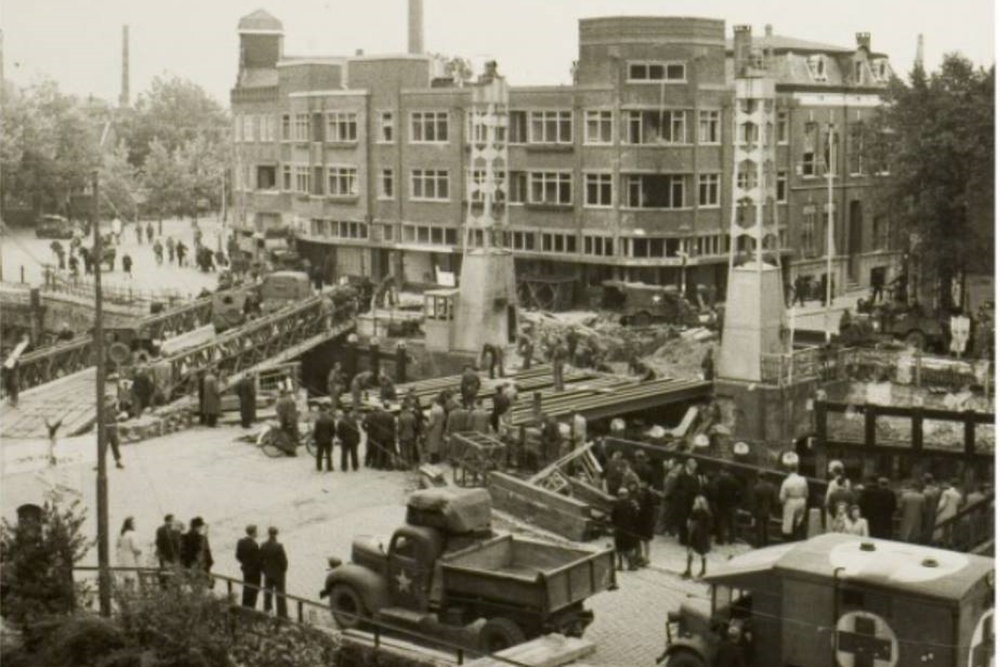
The Bailey bridge next to the blown Veestraat bridge in the center of Helmond Source: Photo archive Jeroen Koppes.

A different photo of the Veestraat bridge. The lower sign with number 990 indicates the headquarters of the 31st Tank Brigade Source: Tim Gainsford
Lion Force organised the defence as follows: outposts were placed between the current Wethouder van Wellaan and the canal diversion at the Deurneseweg. A platoon of 40 men was stationed here, commanded by Lieutenant Johnson. Behind, around the current crossing of Molenstraat and Burgemeester van Houtlaan, further defences, designed to slow down the enemy, were manned by two sections of 116 Pioneer Company, totalling 50 troops, commanded by Captain Thomas. Reinforced defences were placed at the crossing of Molenstraat and Noord-Koninginnewal, with yet again two sections of a total of 50 men of 116 Pioneer Company, here commanded by Major Napier.[43].
At the marketplace, the defence focused on - as stated in the operational instructions - a 'tank killing area'. Soldiers were stationed at the south, east and north sides of the market square: 65 to the south, 40 to the east, and 25 to the north. Another 52 men were stationed ot the west, at the eastern side of the Bailey bridge across the canal, with the clear instruction not to blow up the bridge without orders. Reserves were stationed at the Lion Force headquarters in the Van Vlissingen factory (now Vlisco) on the Groenewoud.[44]
Mercury Force
This force consisted of 222 Pioneer Company[45] commanded by Major Riadore.[46]. Initially, Second Army Signals was stationed here commanded by Captain Reeves[47], however from October 30, the 222 Pioneer Company replaced the 31Tank Brigade.[48]. There was also support from no. 3 Troop, 257 Corps Delivery Squadron commanded by Captain Shelley with five Shermans and a Sherman Firefly.[49]. Based on the western side of the canal, they were also tasked with preventing the Germans from crossing[50] and specifically to defend the bridge near Waardstraat and the road leading to Bakel.[51]
Dynamite Force
This force comprised the 614th Road Construction Company commanded by Major M.A. Grace[52], totalling four platoons. The headquarters was located in the mission house Christus Koning in the Brouwhuis neighborhood. The unit would serve as a mobile reserve for Knightsforce and was placed on alert at its headquarters. They also supplied explosives for the bridges, so if necessary and when ordered by the commander of Knightsforce, they could be blown up. Explosives were planted on 29 October under the direction of Captain Harley.[53]. In addition, the company was to set up roadblocks and lay minefields, should this be requested by the commander of Knightsforce. Finally, Dynamite Force was tasked with patrolling the canal.[54]. This unit was supplemented with a platoon formed of troops from the work shop of 257 Corps Delivery Squadron. The 30 troops were commanded by Staff Sergeant Major Hall.[55].
The 257 Corps Delivery Squadron was also tasked, when ordered accordingly, to bring all non-essential vehicles with 'maximum valuable stores' back across the bridges, before they were blown up. They were to assemble in Aarle and prepare for withdrawal through Eindhoven to Brussels, should the situation deteriorate.[56].
Any casualities were to be cared for in two Regimental Aid Posts: one next to Triangle Force's headquarters, one next to Lion Force headquarters. The wounded would then be transferred to no. 7 Field Dressing Station at 20 Markt in Zaal van Vilsteren, next to the Bioscoop Centraal, and possibly evacuated to 34 Casualty Clearing Station in Geldrop later on.[57].
On 29 October there was another instruction from Knightsforce. Small arsenals were to be set up by the different headquarters in the city and tanks were to be loaded with ammunition. At the same time, 50,000 sandbags were filled. All troops were supplied with enough rations for four days, plus an extra day of 'chocolate emergency rations'.[58].
On 29 October, Niessen wrote in his diary: 'In the mornings I assist the evacuees from Deurne, which is again under fire. Liessel is again in German hands and they have launched a major attack [...] there is great danger of a breakthrough. [...] There is a lot of movement on the road and in the sky, everything is tense because of this sudden German attack.'[59]. On the Stiphoutseweg a Scottish ammunition truck was burning.[60].That evening at 18:45, bombs fell on Mierlo-Hout, next to cafe Adriaans at number 26 and next to the old Sevens mill, damaging it. The Kam family reported a 2.000 pounder in their back garden at no. 3, causing a 16 yard wide crater. There was a lot of material damage to houses, but only two slightly wounded casualities.[61]. At 22:30 another bomb impact was reported, this time in the Strohulzenfabriek on the canal dyke next to the Cacaofabriek. This also was a 2,000 pounder as well which caused some damage.[62].
Captain Gainsford of the 11th Armoured Division was stationed in Helmond and went to inspect the damage caused by the first bombardment. Once back with his troops he wrote: 'At 22:30 the German planes came back and many more bombs fell. They shook the place up quite a bit, but they still missed us and the bridge!'[63]. Toos Rongen, who lived on Kerkstraat at the time, wrote in her diary on October 29: 'A tense day. Helmond is under the threat of returning Germans’. There is enormous troop movement. Maybe the Scottish will come back. Together we shall go to church. But I couldn’t pray very well. The whole time you heard shooting and tanks rolling through the streets.'[64].
At the end of the day, all three brigades of the 15th Scottish Division had arrived in the area between Deurne and Asten. A report came in that the Germans had left Liessel, however the next morning they were back.[65].
Definitielijst
- Brigade
- Consisted mostly of two or more regiments. Could operate independently or as part of a division. Sometimes they were part of a corps instead of a division. In theory a brigade consisted of 5,000 to 7,000 men.
October 30
On the 30th Niessen wrote: 'It is busy in the city once again, the Germans have forced a breakthrough and have occupied Liessel, but were forced back. The worst of the danger seems to have passed, but it has become a lot more difficult to enter or leave the city.'[66]
A situation report from 20:00 on October 30 indicates that the Germans still occupied Liessel, but the Scots were stationed less than a mile away in a ring around the village, to the west, to the north (Loon) and to the east. Near Miegel (most likely Meijel), it was reported that a German footbridge had been made suitable for vehicles.[67]. The 614th Road Construction Company wrote in their war diary that the 'situation is still very serious'. A telephone connection was established with the headquarters of Knightsforce for 'constant communication, day and night.'[68].
Every bridge over the canal in Helmond was loaded with charges and guarded. From north to south, the charges were laid on the bridges on the canal and the Aa in Waardstraat, on the Bailey bridge and on the footbridge in Veestraat, on the railway bridge, and finally on Sluis 8.[69]. The Veestraat bridge and the tram bridge were still in ruins at the time. In total, three NCOs and 15 soldiers guarded the bridges. Each bridge was guarded by at least one soldier. The soldiers were supplied by the four ‘forces’, every day a different force was responsible for the security of the bridges[70].
Despite the threat, dancing in Helmond went on. Captain Gainsford went to one of those parties: 'It wasn’t bad, but it wasn’t good either. I didn’t dance at all, but drank a vast quantity of gin. [...] I came back at midnight, rather drunk'[71].
On 31 October a message arrived that two German soldiers wearingh American uniforms had been spotted. Two infantry sections from 257 Corps Delivery Squadron were sent out on patrol[72], but nothing was found[73]. Niessen wrote: 'It is very busy with troops heading to Deurne, and shells are still falling on the village. It seems to be going well on all fronts'[74].
That day, Antoon Derks from De Mortel wrote in his diary: 'Went to Helmond this morning. There was a sentry on the Scheepstal bridge. Entry to Helmond was strictly at one’s own risk, and exit was granted only with a pass from the Commander of the Binnenlandse strijdkrachten (Domestic Armed Forces). After a lot of difficulty and a long wait (2 hours), I got the pass in Helmond'[75].
The same day, Liessel was taken by the Scots of the 46th Brigade[76]. The 9. Panzer-Division and the 15. Panzergrenadier-Division had retreated behind the canal in the night of October 30 to 31. German infantry took over the battlefield, though still supported by armored units and artillery[77].
The previous reports of Tiger tanks in the area turned out, afterwards, to have been inaccurate. Both the PzKpfw V Panther and the PzKpfw VI Tiger tanks were too heavy to cross the bridges over the canal. The heaviest tanks used by the Germans in the area were PzKpfw IV vehicles[78].
On November 5, Brigadier Knight returned from leave to resume command of Knightsforce[79]. Two days later, on November 7 at 18:00, the unit was disbanded[80]. The explosive charges were removed from the bridges[81], which were no longer guarded[82]. The threat to Helmond was over. Helmond continued to suffer from the war for many months, principally from air strikes. The hardship was not yet over for the civilian population, as more people were killed.

Churchill tanks of the 6th Guards Tank Brigade supporting the 15th (Scottish) Division during the attack on Liessel, November 2 1944 Source: IWM B 11656
Notes
- Onder de Bescherming van de Engel Gabriël, p. 207.
- The Fifteenth Scottish Division, p 185 gives 28 miles
- Battle of the Canals, p 10-13 & The Fifteenth Scottish Division, p 185
- Battle of the Canals, p 13
- Battle of the Canals, p14 & WO 171/288.
- Battle of the Canals, p 10, The Fifteenth Scottish Division, p 186 & The Forgotten Victor, p 238
- WO 171/288
- Battle of the Canals, p 17 & WO 171/288
- Battle of the Canals, p 19 & WO 171/288
- Dagboek van mijn vader, p 142
- Battle of the Canals, p 21
- WO 171/466
- The Forgotten Victor, p 238
- Notes George Wilson
- Was in the villa of the Coovels family, 13 Warandalaan, Onder de Bescherming van de Engel Gabriël, p. 201. Tac HQ had been relocated to Mill on October 3. Rear HQ was still in Helmond, Airbases of Gemert, Bakel, Helmond, p. 57
- Monty's Northern Legions, p. 171, WO 171/1226 & Aantekeningen George Wilson
- Heem Archive, 29.48 Ottenheijm
- Dagboek Niessen
- RHCe 11004.991
- Assault Division, p 129
- WO 171/288
- WO171/877
- The Fifteenth Scottish Division, p 188/189, Battle of the Canals, p 29 & WO 171/288
- WO 171/3099
- 10-09-1906 - 1964
- WO 171/634 & WO 171/288
- WO 171/885
- WO 171/634
- WO 171/634
- No Shortage of Tanks!, p 13.
- IWM.org.uk
- WO 171/1659, WO 171/3171 & WO 171/3099
- WO 171/885
- WO 171/885
- WO 171/885
- WO 171/634
- WO 171/3099, WO 171/885 & WO 171/649
- WO 171/649
- WO 171/885
- WO 171/885 & WO 171/649
- WO 171/634, WO 171/649 & WO 171/3099
- WO 171/3099
- WO 171/649
- WO 171/649
- Initially, Second Army Signals commanded by Captain Reeves was recorded (WO 171/885), later, on October 30, corrected: 222 Pioneer Company. (WO 171/3099).
- WO 171/3171
- WO 171/885
- WO 171/3099
- WO 171/885
- WO 171/885
- WO171/634
- WO 171/885 & WO 171/1659
- WO 71/1659
- WO 171/885
- WO 171/634 & WO 171/885
- WO 171/885
- WO 171/634
- WO 171/3099
- Dagboek Niessen
- Dagboek Niessen & My War Diary, p 140
- RHCe 11004.991
- RHCe 11004.991
- My War Diary, p 140
- Heemkunde, 29.54 Rongen
- WO 171/466
- Dagboek Niessen.
- WO 171/3099
- WO 171/1659
- WO 171/3099
- WO 171/3099.
- My War Diary, p 143-144
- WO 171/885.
- WO 171/885
- Dagboek Niessen
- Het dagboek van Meester Derks, p 22
- The Fifteenth Scottish Division, p 195, WO 171/288 & Monty's Northern Legions, p 172
- The Fifteenth Scottish Division, p 195 & Monty's Northern Legions p 172.
- The Fifteenth Scottish Division, p 195 & WO 171/288
- WO 171/634
- WO 171/1659
- WO 171/634.
- WO 171/3099
Definitielijst
- Brigade
- Consisted mostly of two or more regiments. Could operate independently or as part of a division. Sometimes they were part of a corps instead of a division. In theory a brigade consisted of 5,000 to 7,000 men.
Information
- Article by:
- Jeroen Koppes
- Translated by:
- Tomas Brogan
- Published on:
- 01-03-2023
- Last edit on:
- 30-09-2024
- Feedback?
- Send it!
Related books
Sources
- BAYNES, J., The Forgotten Victor, 1989.
- DELAFORCE, P., Monty's Northern Legions, Fonthill, 2014.
- ELSEN, P. VAN DEN & OTTEN, A., Het dagboek van Meester Derks, Heemkundekring "De Kommanderij Gemert", Gemert, 1980.
- FORTIN, L., British Tanks in Normandy.
- GAINSFORD, A.P., My War Diary, 2012.
- MARTIN, H.G., The Fifteenth Scottish Division, The Naval & Military Press, Uckfield, 2014.
- SCARFE, N., Assault Division, Spellmount, Stroud, 2016.
- VONK, S. e.a., Onder de Bescherming van de Engel Gabriël, Heemkundekring Helmond-Peelland, Helmond, 1994.
- WERFF, L. VAN DE, Dagboek van mijn vader, Helmond, 2019.
- WESLEY JOHNSTON, W., Battle of Canals, 2014.
- WILDEKAMP, R. e.a., Oorlogsvliegvelden van Gemert Bakel Helmond, Heemkundekring De Kommanderij, Gemert, 2011.
- NIESSEN, A., Dagboek.
- GULLACHSEN, A., No Shortage of Tanks!, Canadian Military History, Volume 27, Issue 1, 2018.
- Notes George Wilson, 7th Battalion, Seaforth Highlanders, 15th (Scottish) Infantry Division.
- IWM.org.uk, Badge, unit, 2nd Air Formation Signals.
Archives
- Helmonds Heem, Doos 29.48, Interview Ottenheijm.
- Helmonds Heem, Doos 29.54, Interview Rongen.
- RHCe 11004.991 Luchtbeschermingsdienst taakuitoefening. Rapporten bominslagen.
- WO 171/288, G., 8 Corps, 1944 Oct.
- WO 171/466, G. 15 Infantry Division, 1944.
- WO 171/634, H.Q., 31 Tank Brigade, 1944 Sept.-Dec.
- WO 171/649, R.E.M.E. Wksp. 46 Infantry Brigade 1944.
- WO 171/877, 141 Regiment Royal Armoured Corps, ROYAL ARMOURED CORPS, 1944.
- WO 171/885, 257 Corps Delivery Squadron, ROYAL ARMOURED CORPS, 1944.
- WO 171/1226, 659 A.O.P. Sqn. - 1944 Sep – Dec.
- WO 171/1659, 614 Coy, Companies, 1944.
- WO 171/3099, 116 Coy, Companies, 1944.
- WO 171/3171, 222 Coy., Companies, 1944.
Thanks to:
- Fred Bolle
- Ad Hermens
- Giel van Hooff
- Marcel Kuster
- Jeroen Niels
- Kevin Prenger
